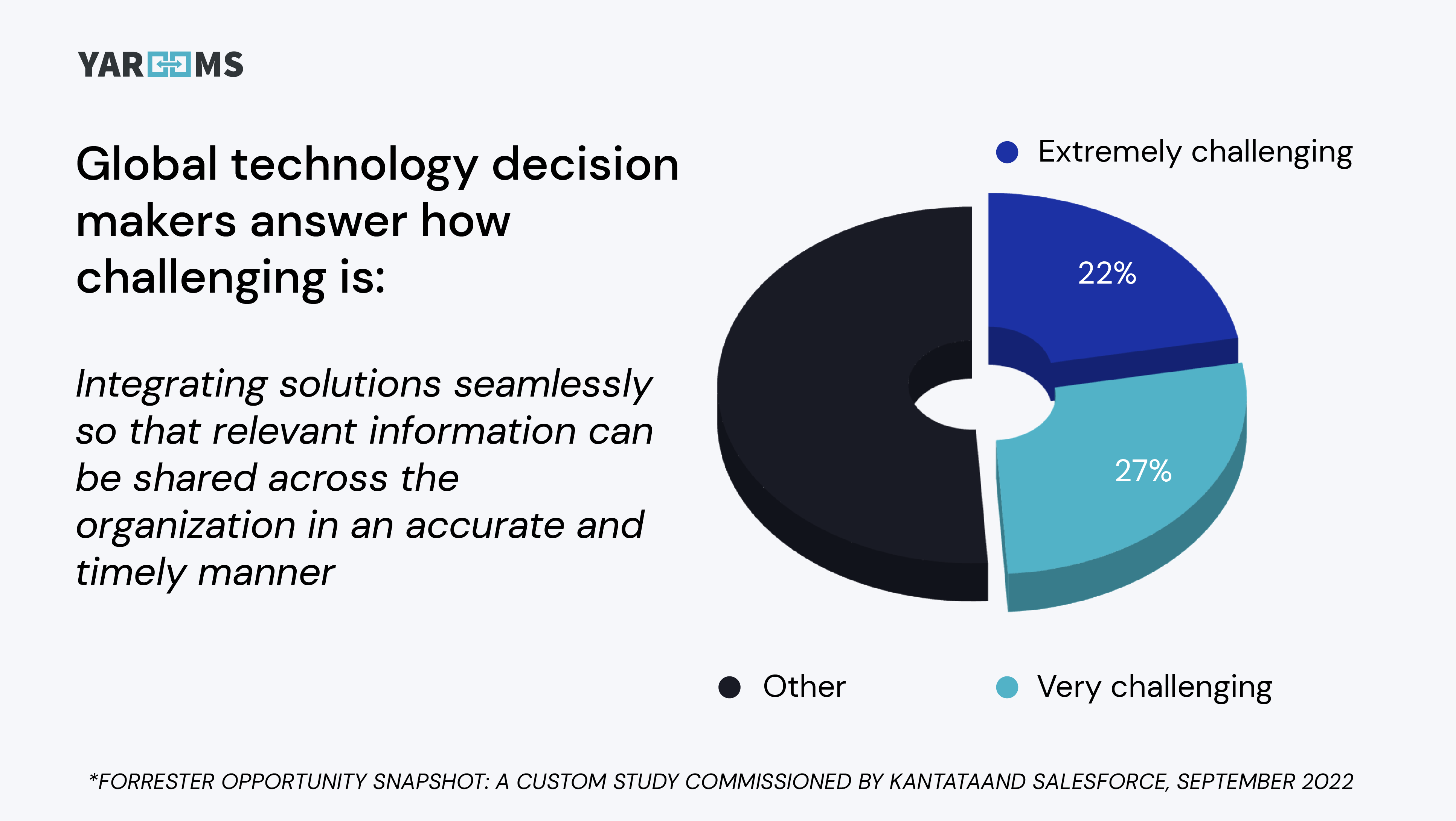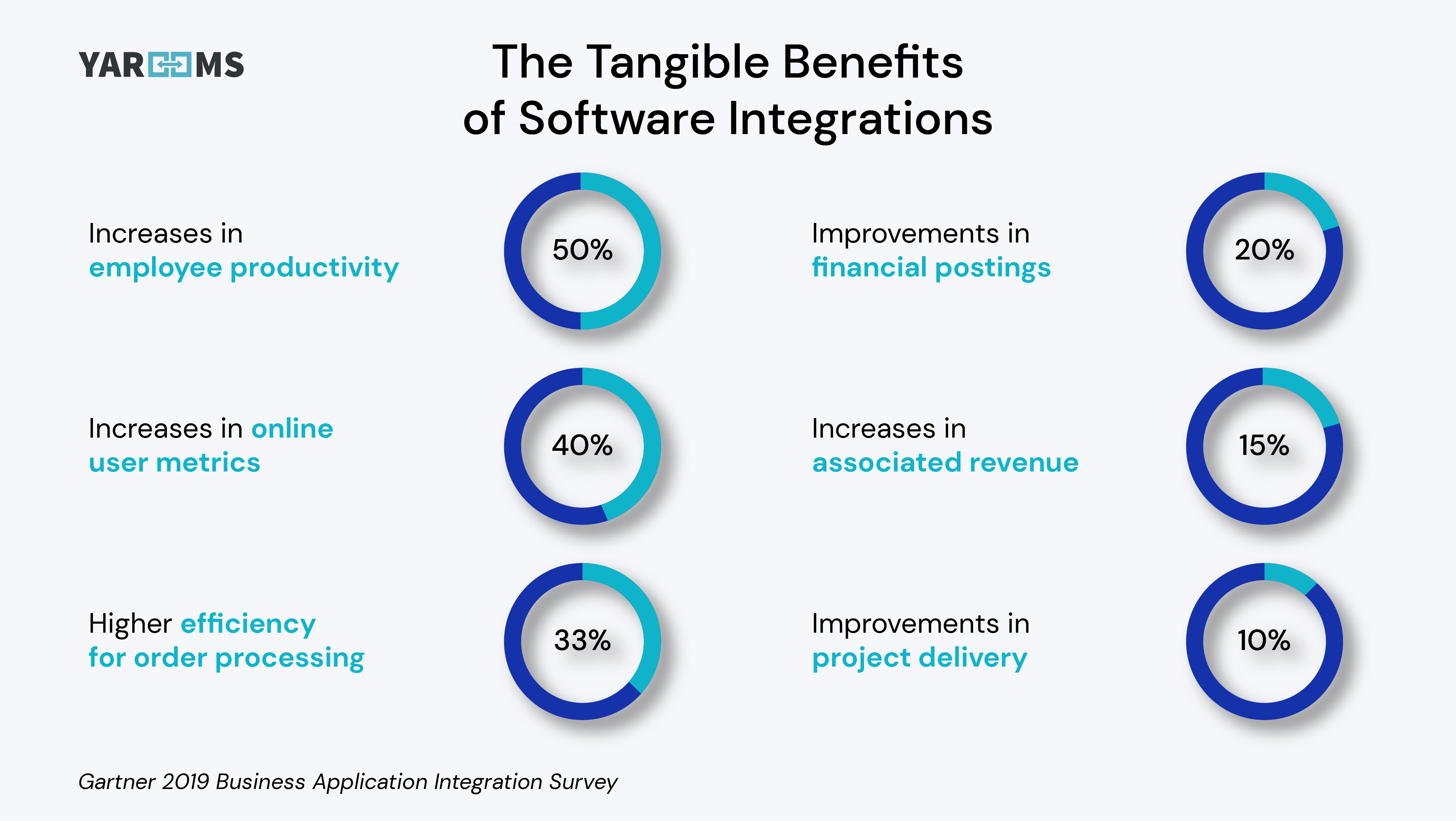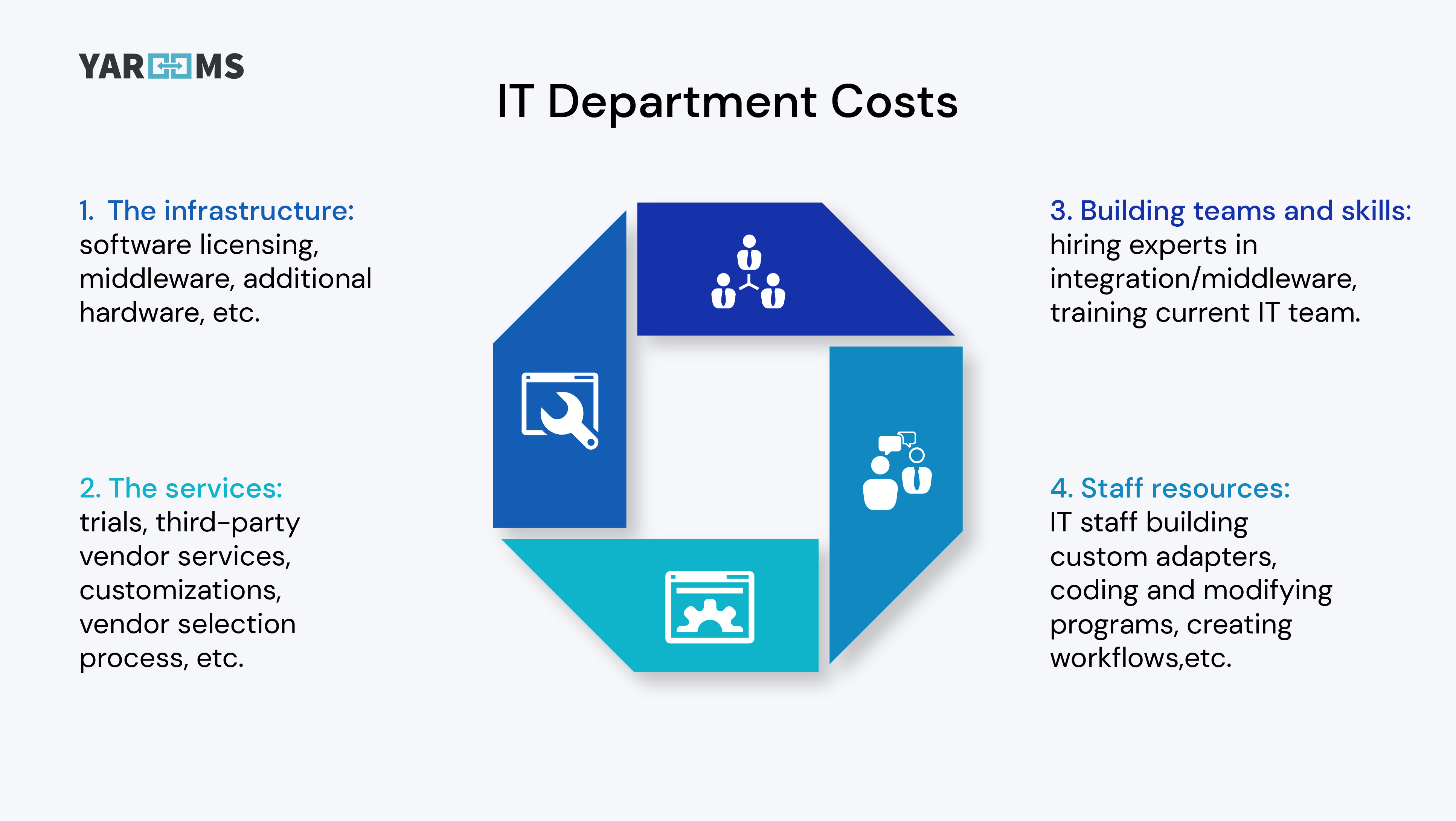In today's world, a great workplace runs on a healthy IT ecosystem, and successful software integrations are a critical component of that ecosystem. However, for many companies, integrating software is not as simple as it seems. In a new research from Kantata and Salesforce, which saw Forrester Consulting ask 383 professional services decision-makers about their challenges, 50% of respondents said they found it very challenging to integrate solutions in their current tech stack seamlessly to share relevant information across the organization in an accurate and timely manner. Which is why, in this article we aim to explore workplace software integration, its ROI, common speed bumps, and proven ways of integrating management software with other tools, complete with real-life examples.
TL;DR:
- The process of software integration involves connecting two or more separate software systems to create a unified ecosystem that streamlines workflows and enhances overall efficiency.
- The benefits of workplace software integration are countless, ranging from tangible benefits such as increased productivity, time savings, employee satisfaction, and lower overhead for the IT department to intangible ones, like improvements in corporate image, intellectual capital gained, destruction of data silos, improved agility, etc.
- Identify the red flags that suggest that your workplace might benefit from better software integration.
- Become aware of the challenges you may face when it comes to workplace software integration such as security, complexity, and costs, and find efficient ways to overcome them.
- Discover proven ways of integrating management software with other tools to tap into new productivity potential.
What Is Workplace Software Integration in the First Place?
Software integration refers to the process of connecting two or more separate software systems to create a unified ecosystem that streamlines workflows and enhances overall efficiency. In the context of the workplace, software integration helps businesses to automate manual processes, reduce redundancy, and provide real-time access to critical data.

The ROI of Workplace Software Integration
The benefits of workplace software integration are countless, ranging from tangible benefits such as increased productivity, time savings, employee satisfaction, and lower overhead for the IT department to other so-called intangible ones. For instance, according to the Gartner 2019 Business Application Integration Survey, respondents reported tangible benefits like: increases in employee productivity (15%), improvements in project delivery (50%), increases in online user metrics (30-40%), higher efficiency for order processing (33%), increases in associated revenue (10%) and improvements in financial postings (20%).

In addition to these tangible benefits, software integration also provides intangible benefits that contribute to the long-term health of the organization. These benefits include improvements in corporate image, intellectual capital gained, destruction of data silos, and improved agility, contributing to increased workplace efficiency. But how do you calculate the ROI of software integration?
Calculating the ROI of Software Integration
This process involves considering several factors and multiple stakeholders. Some of the most important considerations include the initial investment required for integration, ongoing maintenance and support costs, time savings, and the impact on employee productivity and satisfaction. It is also important to consider the impact on customer satisfaction and revenue, as well as any regulatory compliance requirements.
The IT department will look at costs related to:
- The infrastructure, such as: software licensing, middleware, additional hardware, etc.
- The services: trials, third-party vendor services, customizations, vendor selection process, time spent creating RFPs (request for proposal), reviewing RFPs.
- Staff resources: IT staff building custom adapters, coding, and modifying programs, creating workflows, updating industry standards in systems, tracking and resolving issues, doing performance monitoring, etc.
- Building teams and skills, e.g., hiring experts in integration/middleware, training current IT team.

On the other hand, from a business perspective, the costs relate to:
- The time investment - transitioning processes and training teams, edits to organizational structure.
- Outside investments: technology and training costs for external partners connecting to integration.
- Opportunity costs: loss of revenue due to late offerings on the market, lost sales during transition period, lost productivity due to system down time.
In conclusion, when calculating the ROI of software integration, you need to consider a holistic view of costs that includes both licensing the software, services, and operational costs, as well as costs that can be more difficult to calculate but with great impact on the good functioning of the business. The efficiency gains achieved through integration often pay for the investment in a relatively short amount of time.
Signs That Your Workplace Might Need Better Integrations
Some of the red flags that suggest that your workplace might benefit from better software integration include decreased productivity, an increase in time spent on manual tasks, lower employee satisfaction, and higher IT overhead. In many organizations, misaligned software tools can lead to wasted time and resources without the organization realizing it. Spotting the signs of poor software integration is not always straightforward, but some aspects to look out for include recent increases in sales failures, unexpected loss of customers, recurring staff turnover, and a drop in employee productivity. These indicators may suggest that the organization's systems are not functioning as efficiently as they could be, and that better software integrations are needed to improve workplace efficiency and productivity.
Workplace Software Integration Speedbumps (And How to Drive Over Them)
Security, complexity, and costs are some of the significant speed bumps that organizations often face when integrating workplace software. However, these issues can be overcome with the help of vendors that specialize in software security, and by finding tools that can integrate systems in a cost-effective manner.
Security
Security is a critical concern when it comes to workplace software integration. Organizations must ensure that the integration process does not compromise the security of their data or systems. Finding vendors that are leaders in software security is a crucial step towards achieving this goal. Such vendors can help organizations build a complete platform for securing information across the enterprise, from the network to the endpoint. This includes implementing encryption, access controls, and monitoring tools to safeguard sensitive data that help organizations integrate their software systems with confidence and ensure that their data remains secure.
Complexity
The complexity of the systems involved is another significant challenge when it comes to workplace software integration. There are often multiple stakeholders involved, including different departments, vendors, and third-party providers. Additionally, there are a lot of employees who will be affected by the integration, each with their own unique requirements and preferences. Connecting all these dots can be a real challenge for IT teams. It requires careful planning, effective communication, and collaboration between all stakeholders, while the IT teams must have a comprehensive understanding of the various systems involved and how they interact with one another.
Costs
Costs are another significant challenge when it comes to integrating workplace systems. The initial investment required to integrate multiple systems, fix big long-lasting problems, and train employees on the new system can be substantial, especially for large organizations.
Moreover, ongoing maintenance and management costs can add up over time. In 2020, integration services represented over 40% of global IT expenditure, highlighting the significant cost of integration in a market estimated at more than 330 billion dollars. Partnering with a React Native agency can help businesses optimize these costs by building scalable, cross-platform solutions that reduce the need for multiple native applications and cut down long-term maintenance expenses. However, it is essential to consider the ROI of integration, which can be significant, including increased productivity, improved data accuracy, and decreased overhead.
Nevertheless, while integration can be costly, organizations can achieve their desired outcomes without crazy costs or implementation overhead, by taking a strategic approach and leveraging cost-effective integration tools, such as YAROOMS.
YAROOMS solutions remove the bottlenecks that can prevent organizations from achieving their desired outcomes and enable them to streamline their workplace management processes more effectively, offering flexible and easy-to-use integrations. Find out more!
-1.png?width=928&height=523&name=Blog%20post%20photos%202%20(1)-1.png)
4 Proven Ways of Integrating Your Workplace Management Software with Other Tools (+ Real-Life Examples)
There are several proven ways to integrate workplace management software with other tools that can help organizations achieve their desired outcomes. Let’s find out what are the most common.
Single Sign-On
Single sign-on (SSO) is an authentication process allowing users to securely access different apps or systems using only one set of credentials. With SSO, users can access multiple applications with a single login, which saves time and reduces the need for IT support. Additionally, SSO reduces the risk of password-related security incidents, such as phishing attacks, by allowing users to use strong, complex passwords that are easier to remember. By implementing SSO, organizations can enhance security, improve productivity, and provide a better user experience for their employees.
For instance, YAROOMS offers single sign-on (SSO) capabilities to streamline user authentication and increase productivity. It works with several third-party SSO services, including Azure AD, Okta, One Login, and Google Workspace, to provide users with a seamless, secure login experience. With SSO, users can access YAROOMS and other applications with a single set of credentials, making it easier to collaborate, schedule meetings, and manage resources,
Meeting Integrations
Meeting integrations are particularly useful for hybrid organizations that have both remote and in-office employees. Integrating software such as Google Meet, Zoom, and Teams can help IT teams engage both remote and in-office employees simultaneously, improving collaboration and productivity. For example, YAROOMS offers seamless integration with popular video conferencing tools such as Google Meet, Zoom, and Microsoft Teams. With YAROOMS, users can easily create a Teams/GMeet/Zoom meeting along with a YAROOMS meeting and attach it to the event description. When the YAROOMS meeting is updated, the Teams/GMeet/Zoom meeting will be updated automatically, ensuring that all attendees have the most up-to-date information about the meeting. This integration eliminates the need for manual updates and reduces the risk of scheduling conflicts or miscommunication, helping streamline the meeting scheduling and management processes, saving time and improving productivity.
Calendar Integrations
Calendar integrations, such as those offered by Google Calendar, Office 365, Microsoft Outlook, Mac Calendar, and others streamline scheduling, increase employee satisfaction, and save time by reducing the need for manual scheduling. A very good example is how YAROOMS helps users connect external calendars and view their YAROOMS schedule from popular calendar applications such as Google Calendar, Office 365, Microsoft Outlook, and Mac Calendar. With this integration, users can easily access their schedule from the calendar application they already use, eliminating the need to switch between different applications, which makes the scheduling experience pleasant and user-friendly. This integration also ensures that users always have the most up-to-date information about their schedule, reducing the risk of conflicting or missed meetings.
Microsoft Teams Integration
Microsoft Teams integration is an excellent way to streamline workplace scheduling, improve end-user experience, and increase user adoption. When workplace tools can work within each other, efficiency and productivity are greatly enhanced. YAROOMS integrates with Microsoft Teams enabling users to schedule and manage their meetings directly from the Teams platform, improving collaboration and productivity.
A real-life example of a customer who benefited from YAROOMS and Microsoft Teams integration is Cerved, a leading provider of business information and credit management services in Italy. Cerved was struggling with a complex scheduling process that involved multiple applications and platforms. The company needed a solution that could streamline their scheduling process and improve collaboration between employees. With YAROOMS, Cerved employees are now able to book meetings directly from Teams, reducing the need to switch between multiple applications. The integration also provided employees with real-time access to meeting information, enabling them to make informed decisions and collaborate more effectively.
Custom Integrations
While custom integrations can be more costly and lengthy, they offer businesses the freedom to customize their workplace software and integrate different tools as per their specific requirements. Finding a vendor that is willing to work with you to customize software integration can be a game-changer.
Mercury Insurance, a leading provider of auto and home insurance in the United States, put its trust in YAROOMS to build a solution to streamline their scheduling and reservation process for conference rooms and other shared resources across multiple locations. Because YAROOMS offers custom integration capabilities to meet the unique needs of organizations, the development team created a custom integration solution for Mercury Insurance called Hyperlinks. The Hyperlinks solution enables Mercury Insurance employees to easily reserve conference rooms and other shared resources from their existing email and calendar systems. With the Hyperlinks solution, employees can simply click on a hyperlink in their email or calendar to access YAROOMS and reserve a resource in real-time. The integration has proven to be a valuable tool for the organization, reducing the time and effort required to manage their shared resources.
The Bottom Line
Workplace software integration can be challenging, depending on the solutions you choose. However, with the right approach and tools, workplace software integration can transform your workplace into a highly efficient and productive environment. By following these best practices and leveraging real-life examples, your organization can integrate software systems seamlessly, achieving long-term ROI and increased productivity. It should, thus, be a top priority to look for solutions that offer flexible and easy-to-use integrations to optimize your workplace management processes.

.png)









